Align worker travel service
The Align JV worker travel shuttle service was established in early 2020, with the aim of providing a safe and efficient mode of transport for staff working on the Align JV HS2 C1 project. It consists of a fleet of 18 minibuses and 19 drivers. The free-to-use service has produced an environmental, safety and efficiency legacy by carrying approximately 30% of C1 Align JV staff from local underground and railway stations to Align JV sites. This paper shows how the worker travel team produced a structured and timed service which has reduced CO2 emissions and minimised the impact of the project on local communities, by removing a large number of vehicles from the local road network.
Worker travel data is collected and uploaded to a dedicated PowerBI dashboard created and managed by the worker travel team. Overall, the worker travel services saved over 16 tonnes of CO2 in 2022. The overall success of the worker travel service and lessons learned can provide a good baseline and template for similar projects in the future.
Background and industry context
This paper is presented as part of the works to deliver the Main Works Civils Contract (MWCC) for the central section of High Speed Two (HS2) Phase One which includes the Colne Valley Viaduct and Chiltern Tunnels, being delivered by the ALIGN Integrated Project Team.
Travel mode choice is an important factor to assess for any large trip generator or trip attractor such as a large construction site. In 2021 transport accounted for 26% of UK greenhouse gas emissions, with cars and taxis accounting for 52% of domestic transport emissions in 2020(1). Commuting accounts for around one in five car journeys in the UK, with vehicle occupancy 26% lower than for car journeys as a whole(2). Reducing single occupancy commuting journeys by 10% could potentially save 500,000 tonnes of CO2 annually(3). The HS2 Code of Construction Practice(4) states that the lead contractors will be responsible for preparing construction workforce travel plans, with the aim of encouraging the use of sustainable modes of transport to reduce the impact of workforce travel on local residents and business. Objectives to support these aims will include:
- effective management of construction worker traffic to minimise damage to the environment, impact on the surrounding road network, danger to road users and disturbance to neighbouring properties; and
- the introduction of measures to reduce single-occupancy car journeys by staff working on construction sites through the encouragement of car sharing, use of available public transport, cycling and walking to work where reasonably practicable.
Approach
Early on in the planning stage of the project, it was apparent that many of the worksites were remote, with little space for parking. Considered alongside the project’s objective of minimising its carbon footprint and the impact on the local community, it was decided that an organised worker travel solution would add value. The Align JV shuttlebus service was established in early 2020 and operated a single shuttle service from Denham railway station to the Align JV main compound. An increased demand for shuttlebus services in 2020, resulted in further shuttle buses and routes being added. Figure 1 shows the shuttlebus timetable, which was produced and provided to Align JV staff in early 2020.
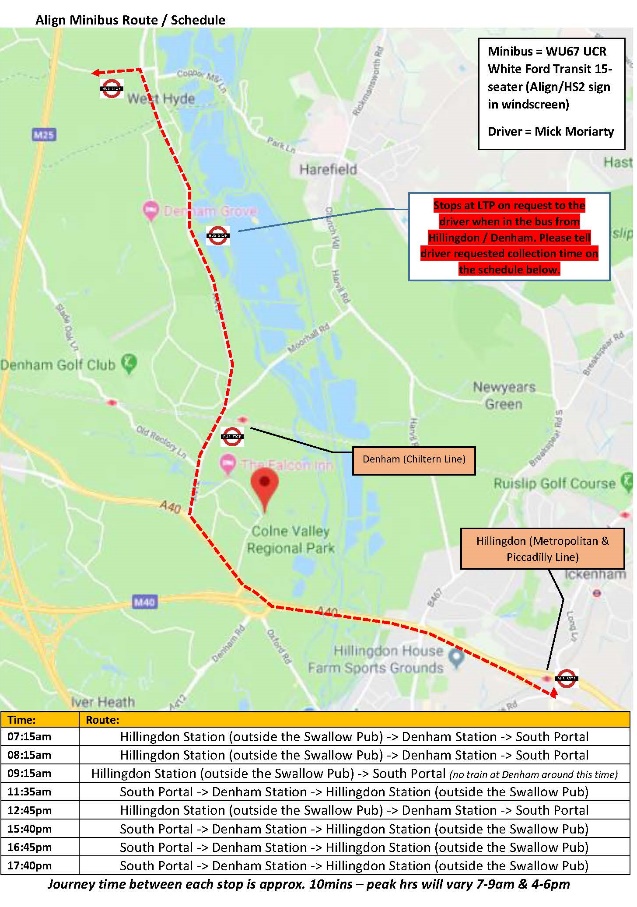
In late March 2020, the UK was in lockdown due to the Covid-19 pandemic. The government guidance was for people to stay at home and work from home where possible. Essential workers were allowed to travel to work but were advised not to use public transport and not to car share. This was difficult due to not everyone owning a car or having a driving licence. Align JV’s worker travel approach and shuttle bus approach had to be changed to accommodate the new restrictions implemented by the government.
In order to understand the worker travel requirements, travel to work surveys were issued to staff. The results of the surveys were used to implement changes to how the shuttle buses operated. A number of changes were implemented, these include:
- Reducing the passenger capacity of the shuttle buses by 50%
- Installation of Perspex screens between the driver and passengers
- Mandatory mask wearing for all passengers
- Provision of free masks and hand sanitiser
- Full cleaning and disinfectant of shuttle buses in between journeys.
Additionally, more shuttlebus services and routes were added in order to accommodate staff travel requirements. The new shuttlebus routes served, Rickmansworth Station, Hillingdon, Denham, Amersham, Watford Junction and Harrow on the Hill.
These routes were added to the worker travel shuttle service by implementing a worker travel Plan survey. The results of the survey demonstrated there was a demand for the new routes to be added.
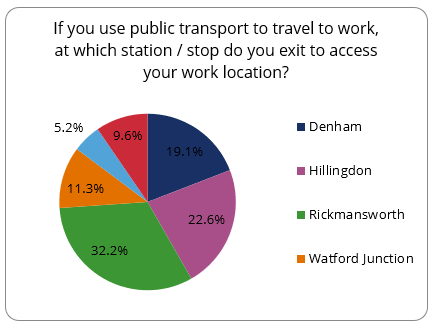
In late 2020, Covid-19 restrictions were partially lifted and many of the Align JV staff were now based on site for a few days a week. There was a large demand for the shuttlebus service between worksites and local rail stations and additionally inter-site travel demand. In order to improve the passenger travel experience and efficiency of the service, new timetables were designed.
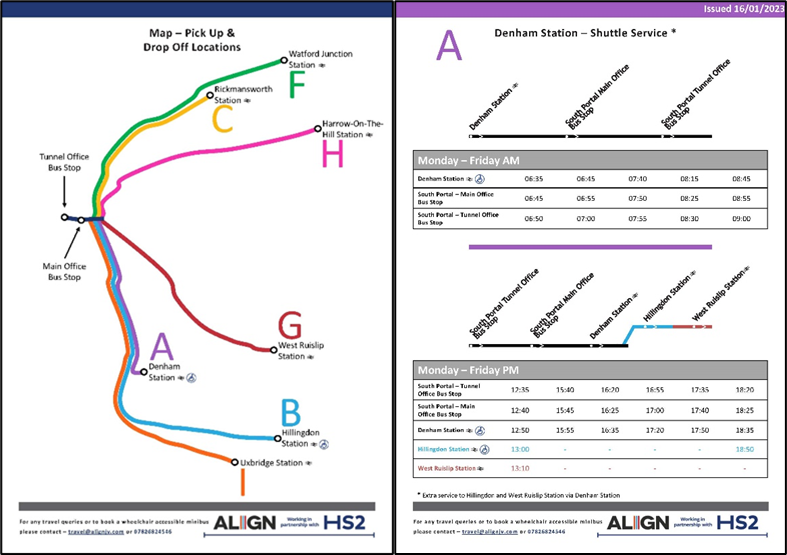
The redesigned timetables were issued staff members via email, digital screens and paper copies posted on site.
Public transport is in operation from Denham and Rickmansworth train stations and can be used by staff to travel to the Align JV main compound. The main challenge faced by using public transport services to the main compound is the frequency of the bus services operated. Public transport buses operate one every hour, this is not practical for staff travelling to the main compound.
On site parking for Align JV staff is available at the main compound but is limited, staff are encouraged where possible to travel to work using public transport and the worker travel shuttles.
Operational Challenges
The worker travel team sits within the Align JV logistics department and is responsible for delivering the entire worker travel package for the project. Staffing challenges include building solid and professional relationships with our approved labour agencies, this is a key requirement for the success of the service. The specific operational challenges centre around annual leave and to maintain adequate staffing levels as the labour agencies need to source the correct licenced personnel. The shuttle buses used for the worker travel service are bound by regulation and can only be driven by holders of a D1 licence.
Vehicle maintenance is a key factor in keeping the worker travel operation running efficiently. The Align JV worker travel team are responsible for driver training, maintenance forecasting and managing vehicle breakdowns and defects.
The operation has grown significantly since 2020, leading to further demand and additional tasks which support the wider project. In particular, direct support is given to the “Visitor and Events” team, who organise an average of 25 external site visits each month to Align JV main compound. The worker travel team delivers site tours for a wide range of external guests and visitors such as the Department for Transport, local authorities, civil servants, media/broadcasters, and other construction companies who are interested in the project.
The worker travel team also provides support to the Align JV community engagement team who work closely with local schools and businesses, engaging with the local community and helping maintain a positive relationship between Align JV, HS2 and the local community. This work has resulted in the worker travel team being nominated and winning the HS2 Quarterly Values award January 2023.
Outcomes
Overall, the worker travel service has been great success. As of February 2023, it operates 18 shuttle buses which includes one WAV (wheelchair accessible vehicle) There are a total of 19 shuttle bus drivers. The shuttle bus service is FORS (Fleet Operator Recognition Scheme) gold accredited.
In order to measure the success of the worker travel service and to forecast capacity and demand of the service, a PowerBI dashboard was created in 2021. The PowerBI dashboard assists the team in producing KPIs (Key Performance Indicators), which are shared with various stakeholders within Align JV and also helps with capacity planning for the shuttle bus services. Figure 4 shows the worker travel PowerBI outputs for 2022.
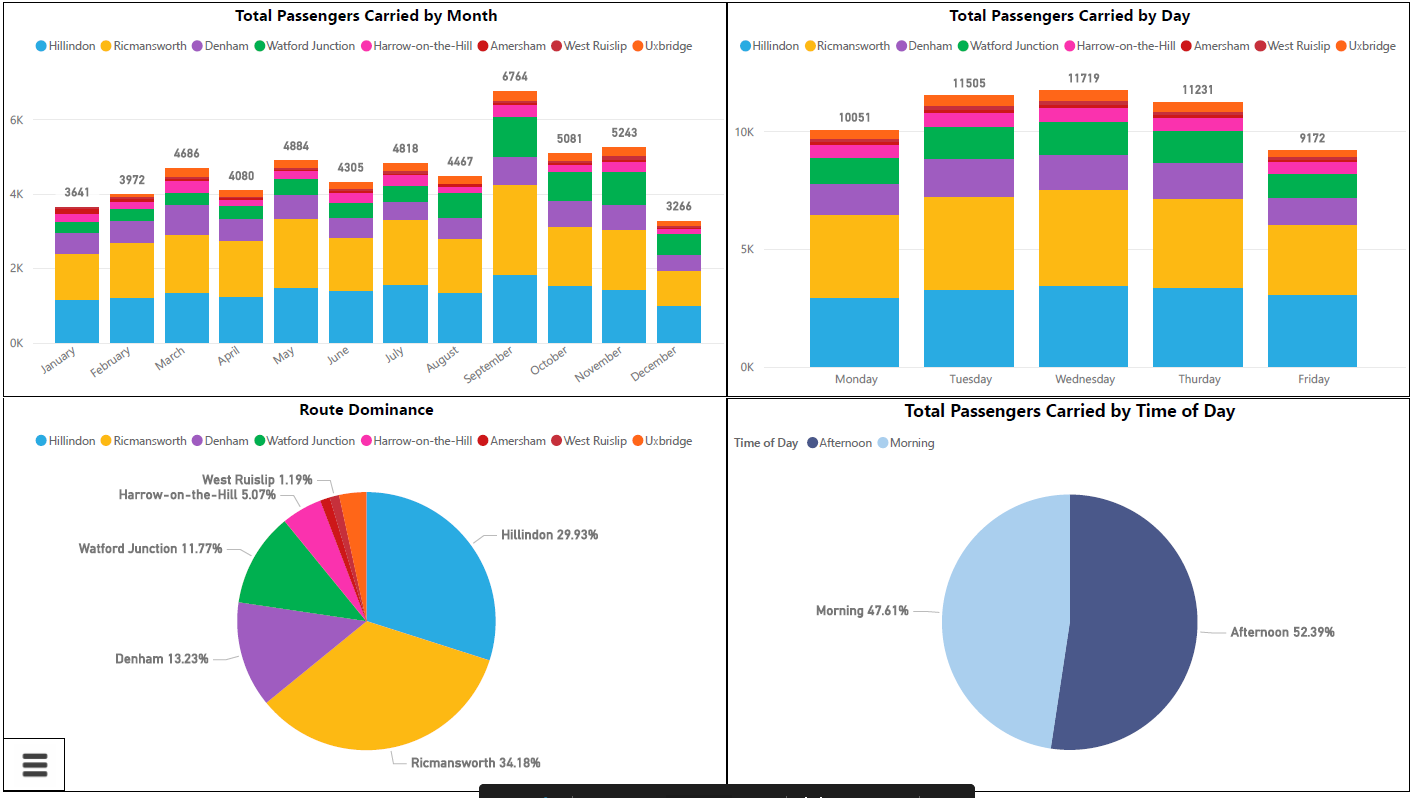
Our worker travel service is the first of its kind across the HS2 project, therefore it was difficult to have benchmarks set against our KPI data. Passenger utilisation for each route is recorded and monitored for determination should the route been kept, merged with another shuttle route, or discontinued. It was deemed that if 30% of Align JV staff were to use the shuttle services, this would be an acceptable figure. To attract more passengers’ additional routes could be added but there is a limit to the catchment area we can service from the main work site and budget limitations. Continuous monitoring of the shuttle service is conducting through our travel plan and passenger satisfaction survey, these both help us to assess whether we can attract more users to the shuttle service.
In 2022 the Align JV shuttle bus service carried a total of 54,009 passengers between worksites and eight local rail stations served by the service. Table 1 provides a breakdown of number of passengers transported and the railway station they were picked up/dropped off from.
| Station | Passengers – 2022 |
|---|---|
| Denham | 7691 |
| Hillingdon | 16001 |
| Rickmansworth | 18261 |
| Amersham | 663 |
| Watford Junction | 6228 |
| Harrow-on-the-Hill | 2713 |
| West Ruislip | 640 |
| Uxbridge | 1812 |
| Total | 54009 |
The Align JV worker travel team also record the estimated CO2 savings due to the shuttle service. Table 2 provides a breakdown of the estimated CO2 savings for the shuttle service.
| Route | Seats occupied | Total passengers (=seats occupied/2) | Total bus CO2 emissions (kg) | Potential passenger CO2 emissions (kg) | Total kg CO2 Saved |
|---|---|---|---|---|---|
| Denham | 7691 | 3845.5 | 4389 | 3778 | -611 |
| Hillingdon | 16001 | 8000.5 | 10351 | 18430 | 8079 |
| Rickmansworth | 18261 | 9130.5 | 4842 | 10624 | 5782 |
| Amersham | 663 | 331.5 | 494 | 217 | -277 |
| Watford | 6228 | 3114 | 4117 | 8027 | 3910 |
| Harrow-on-the-Hill | 2713 | 1356.5 | 3172 | 5635 | 2463 |
| West Ruislip | 640 | 320 | 5333 | 910 | -4423 |
| Uxbridge | 1812 | 906 | 698 | 1906 | 1208 |
| TOTALS | 54009 | 27004.5 | 33396 | 49527 | 16131 |
Total kg of CO2 emissions for shuttle buses is calculated by multiplying the kilometres travelled per bus (from worksite to train station, and back to site) by the grams of emitted (176g/km for a Ford Transit minibus) and dividing this by 1000 to give the kg equivalent.
To calculate the amount of CO2 saved, shuttle bus emissions were compared against the equivalent number of passengers undertaking single occupancy car journeys, using average car emissions of 114g/km as a baseline (5).
Where negative CO2 savings were initially found due to low passenger counts at Denham, West Ruislip and Amersham stations, this was mitigated by combining services to three local train stations (Denham, Hillingdon, and West Ruislip). Combing these services helped to offset the negative CO2 saving. Amersham station was deemed an essential shuttle service due to the lack of public transport available in the surrounding area. Parking facilities at Amersham worksite are limited so a shuttle service to site allows staff to reach their place of work whilst minimising car use.
It is estimated that a total of 16.12 tonnes of CO2 was saved in 2022 due to the shuttle bus service. This figure is likely lower than the true CO2 saving as the calculations assumed passengers started their journeys at a local rail station, whereas in many cases journeys would have been longer, and the CO2 savings would be greater.
Passenger satisfaction is one of the key values adopted by the worker travel team. The team have a dedicated email address, where staff are able to send questions, comments, and ad-hoc travel requests. Additionally, frequent passenger satisfaction surveys are undertaken. QR codes are posted in all the shuttle buses and passengers are able to anonymously complete a satisfaction survey and provide feedback about the service. The Align JV shuttle bus service scored 87% on satisfaction as of the latest satisfaction results from 2022.

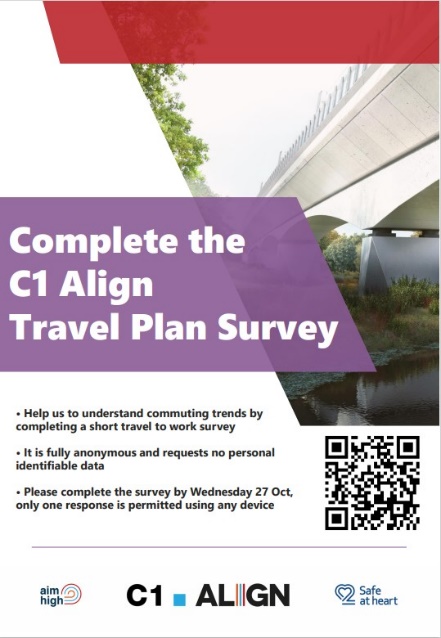
Learnings and Recommendations
The Align JV worker travel shuttle bus service has been operating for over three years and has successfully transported several thousands of passengers and has reduced the carbon impact of the project.
Before commencing a worker travel service there are factors that need to be considered:
- Site assessment and accessibility – The location of the work site and how the site can be reached using local public transport.
- Parking facilities on site – Is there sufficient parking on site for staff? If there is parking how will you encourage staff to use public transport and a proposed shuttle service from surrounding train stations.?
- Demand for a shuttle service – Conduct a survey to establish if there is a demand for a shuttle service.
- Surrounding train stations – What are the local train stations surrounding the site? Do certain train stations need to be included to capture over and underground services.
- Operational restrictions – Are there vehicle or time restrictions if collecting / dropping off at local train stations? Is local authority permission required?
Upon establishing the shuttle bus service, a number of issues were highlighted by passengers, these include the lack of guidance regarding the location of pickup points, unreliable timings of the services, timetables not being visually pleasing and lack of communication between the worker travel team and passengers.
A very important factor is to understand the requirements of the passengers. This can be achieved by establishing direct communication lines between passengers and the operator (worker travel team), either via a dedicated mailbox or frequent surveys. Furthermore, providing passengers with clear and reliable travel information is key to a successful service. Studies have shown that accessibility to a railway station is one of the key factors associated with passenger anxiety(6), by providing a reliable and safe service this can help reduce anxieties associated with travel.
Before launching the shuttle bus service, a lot of research was undertaken, specifically regarding vehicle accessibility at local rail stations. Several of the local rail stations served by the Align JV shuttle bus service have either vehicle height restrictions in the car parks or inadequate turning circles for larger vehicles such as a coach. This research assisted in the procurement of the vehicle types which are currently operated by the Align JV worker travel team.
Frequent reviews of the service and KPIs are essential when operating a successful shuttle service. The team meet on a weekly basis to discuss and resolve issues such as capacity, route changes, new service and other worker travel related issues.
Conclusion
The Align JV shuttle bus service is a free-to-use service, paid by C1 Align, operating between local rail stations and Align JV worksites, additionally providing staff members with inter-site travel services, ad-hoc travel services and external visitor tours. Overall, the worker travel service has saved over 16.12 tonnes of CO2 since the start of the project.
Communication is one of the most valuable factors when establishing a worker travel service serving a large workforce, in addition this has led to a strong collaboration between Align JV and its sub-contractors, resulting in efficiencies in transporting staff from local rail stations and various worksites.
Data collection and analysis has been extremely beneficial when planning and operating the worker travel service.
In addition to the environmental and safety benefits, the shuttlebus service provides accessibility to many of the Align JV staff who do not own a vehicle or have a driving licence. This has overall resulted in Align JV being a more accessible employer.
It is recommended that future projects would benefit by providing such a service, however it is important to conduct research prior to launching a shuttle bus service. Additionally, the worker travel team should understand the travel requirements of the workforce. Clear and efficient communication channels should be established between the worker travel team and workforce, as this will help improve the service and passenger satisfaction.
The overall success of the worker travel service and lessons learned can provide a good baseline and template for similar projects in the future.
Acknowledgements
Emma Robins
Matthew Potter
References
- GOV.UK, Waite C (2022) 2021 UK Greenhouse Gas Emissions [cited 2023 Feb1].
- DfT (2013) Car or van occupancy. NTS0905: Car occupancy, England since 2002.
- DfT (2020) Analysis of National Transport Model Outputs. National Transport Model – Analytical Review
- HS2 Ltd (2017) Environmental Minimum Requirements Annex 1: Code of Construction Practice
- HMRC Official Statistics (2021) Statistical Commentary July 2021
- Cheng, YH (2010) Exploring passenger anxiety associated with train travel Transportation 37, 875–896 (2010)
Peer review
- Shital-Shirsat RohekarHS2 Ltd


